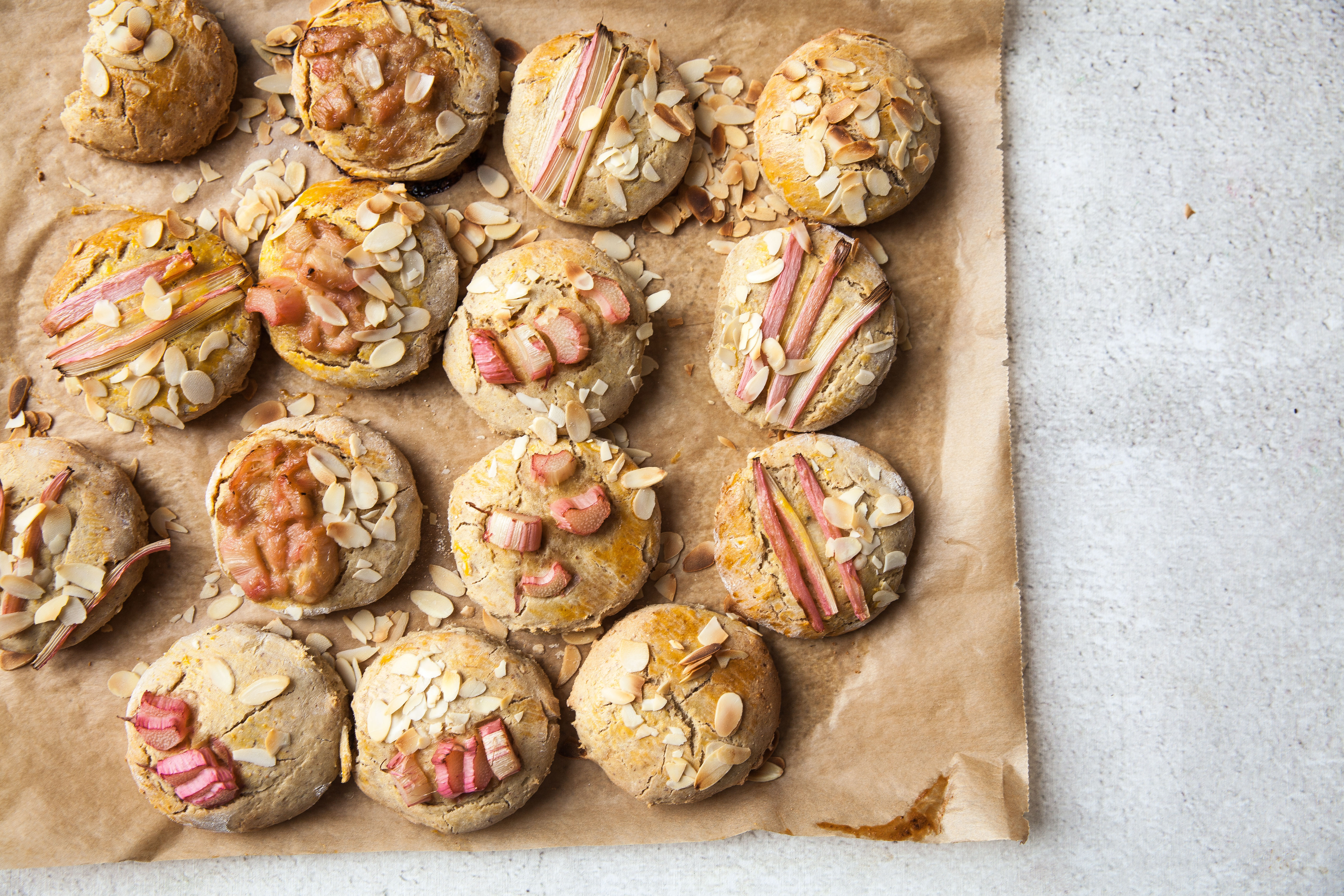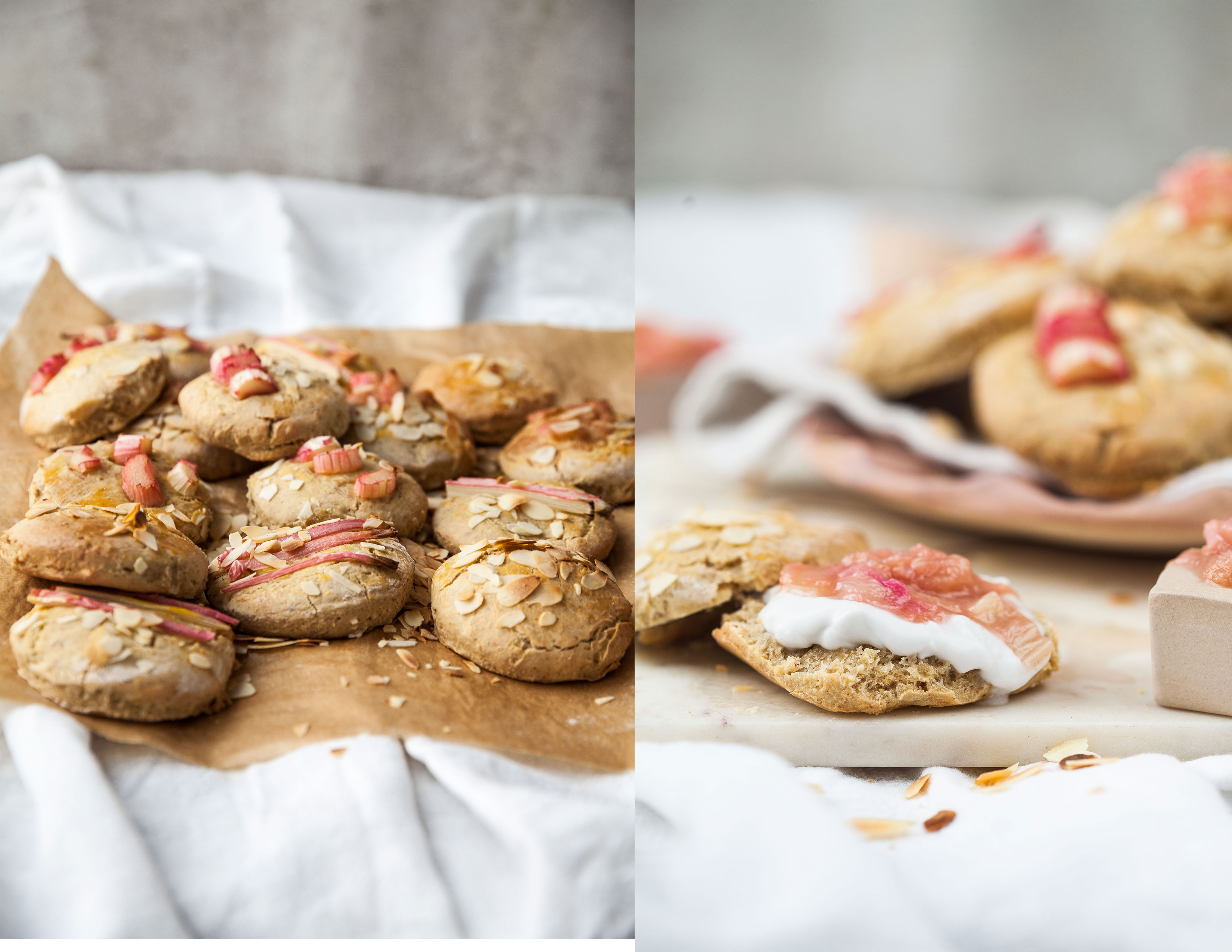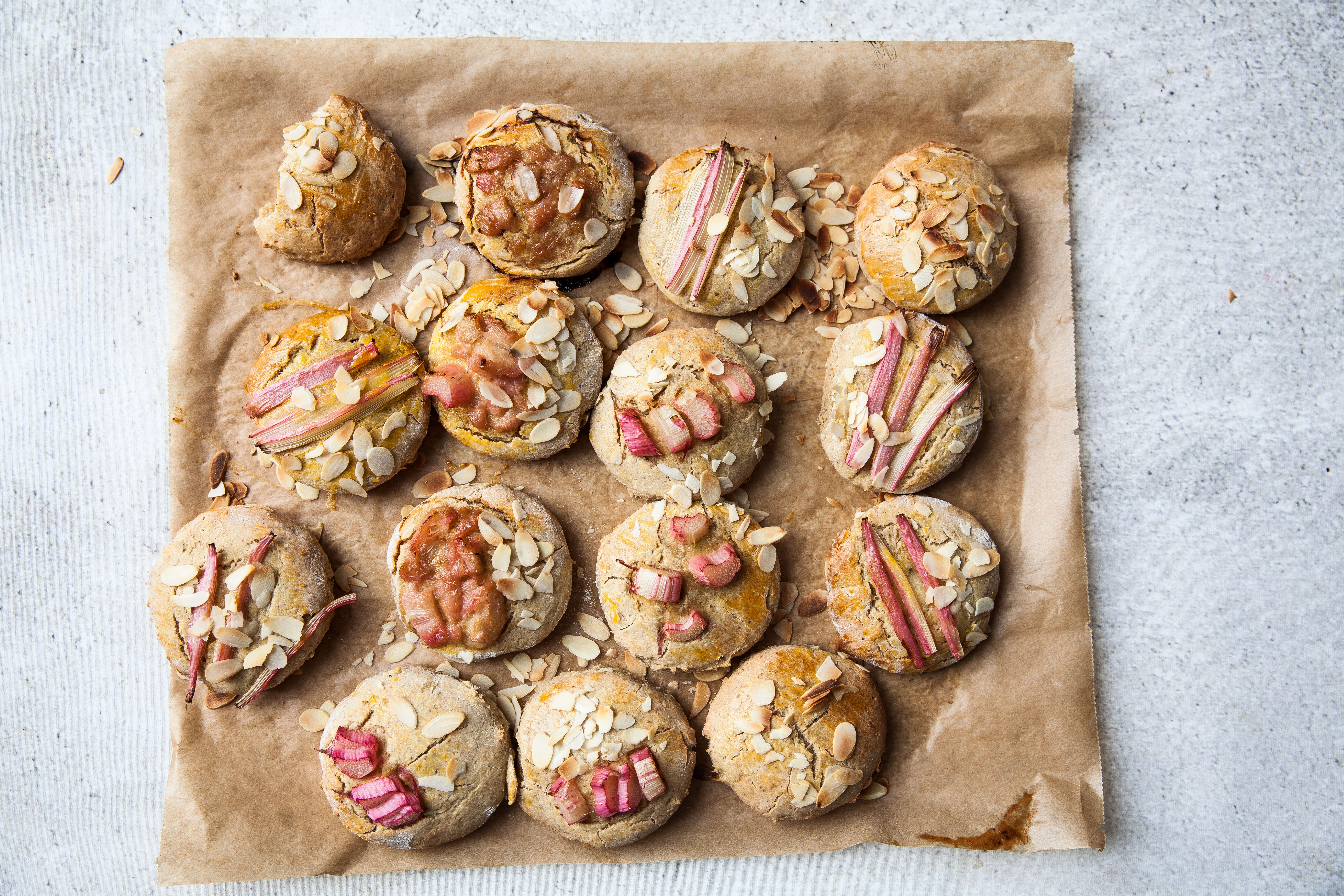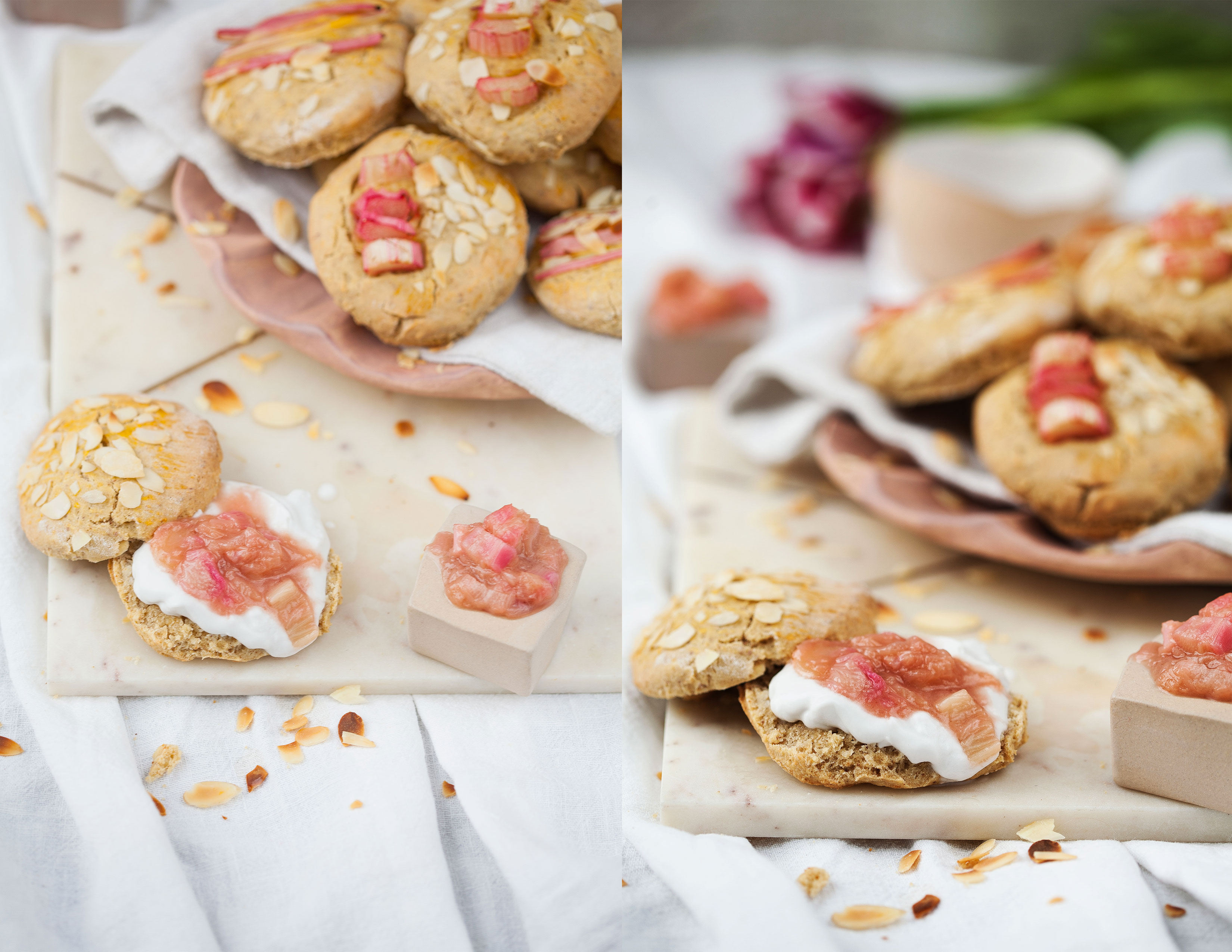Rhubarb Easter Scones
This English classic isn't just good for a delicious afternoon tea, but is also a great breakfast dish as well as a very happy partner to matcha tea or turmeric latte. I personally love scones with a homemade compote or jam, topped with whipped coconut milk.
Die ersten Scones habe ich vor 13 Jahren in Neuseeland gegessen. Damals wusste ich noch nichts von meiner Zöliakie und aß wöchentlich, manchmal auch täglich, die verschiedensten Scones Kreationen. Meine Favoriten waren Dattel-Scones. Meine Gastmama Manon hatte ein ganz spezielles Rezept mit Dosen-Sprite – diese Scones waren total schnell in der Zubereitung und schmeckten herrlich flaumig. Wenn Manon dann am Sonntag zum Nachmittagskaffee die noch warmen (so schmecken sie nämlich am besten) Scones gebracht hatte und diese mit frischer Schlagsahne und Marmelade servierte, war mein Glück perfekt.
Hierzulande kennt man Scones ja nicht so gut, aber dafür haben wir ja auch himmlisches Brioche-Gebäck, das sich vor allem an Ostern großer Beliebtheit erfreut. Die treuen Leser unter euch wissen, dass ich ein riesen Brioche Fan bin und ich es durch meine Zöliakie sehr vermisse. Es ist ziemlich schwer oder fast unmöglich, einen luftigen glutenfreien Briocheteig herzustellen. Letztes Jahr habe ich bereits ein Oster-Brioche-Rezept mit euch geteilt. Da ich dieses Jahr noch immer im Australien-Fieber bin und mich das unweigerlich an meine Zeit in Neuseeland erinnert, wollte ich zu Ostern glutenfreie Scones auftischen. Als ich zum Einkaufen ging und mich die ersten Rhabarberstangen anlachten, entschied ich mich spontan für die frühlingshafte glutenfreie Oster-Scone-Variante mit Rhabarber! Das Ergebnis lässt sich wirklich sehen bzw. genießen, und mit Kokos-Sahne und dem restlichen Rhabarber-Kompott, das man vorher sowieso für den Teig braucht, schmeckt der Scone herrlich. Unbedingt frisch zubereiten – denn noch warm aus dem Ofen schmecken Scones bekanntlich am besten.
Wissenswerte Facts über Rhabarber
Obwohl Rhabarber eigentlich ein Gemüse ist, wird es meist als Obst gesehen und auch gerne wie Obst für Kuchen und Marmelade eingesetzt. Rhabarber hat von April bis Juni Saison. Die Stängel sind nicht zwangsläufig rot bis rosarot, sondern können im reifen Zustand auch grün sein. Interessant zu wissen: je später Rhabarber geerntet wird, desto saurer schmeckt er. Rhabarber kann man roh nicht genießen. Wird er jedoch gekocht, entfaltet er sein wunderbares Aroma. Sein saurer Geschmack ist ein toller Kontrast zum Süßen.
Rhabarber wirkt nicht nur verdauungsfördernd und appetitanregend, sondern hat auch eine entschlackende Wirkung. In Rhabarber stecken die Vitamine A, B1, B2 sowie besonders viel Vitamin C. Außerdem sind die Mineralstoffe Kalzium, Kalium, Magnesium, Phosphor sowie Eisen enthalten. Beim Rhabarber sind lediglich die Stangen genießbar. Finger weg von den Blättern, da diese Oxalsäure enthalten und dies zu Magen-Darm-Problemen führen kann. Zunächst werden die Stängel gewaschen und die Blätter entfernt. Für die Zubereitung eines Kompotts werden die Stangen in kleine Stücke geschnitten und zusammen mit Zucker bissfest eingekocht. Rhabarber schmeckt auch gut als „Crumbles“. Dazu die gezuckerten Rhabarberstücke in eine ofenfeste Auflaufform geben und aus Mehl, Butter und Zucker Streusel herstellen, darüber geben und im Ofen goldbraun backen. In pikanten Gerichten schmeckt Rhabarber gut zu Fleisch und als Dip wie Chutneys zu Käse und Fleisch.
Ich wünsche euch ein wunderschönes Osterfest und viel Freude beim Backen!
Millet and Rhubarb Scones
Ingredients:
Ingredients for the scones:
- 400g ground millet
- 220g gluten-free flour or whole-wheat flour
- 100g ground almonds
- 80g almond flakes
- 1 packet baking powder
- 1 pinch of sea salt
- 1 one pinch of vanilla seeds, scraped from a pod
- zest of 1/2 organic lemon
- 2 eggs
- 2 egg whites
- 6 TBSP coconut oil
- 100ml almond milk
- 100g maple syrup
Rhubarb compote:
- 5 rhubarb stalks
- 2 TBSP coconut oil
- 6 TBSP maple syrup
flaked almonds for decoration
Whipped coconut milk:
- 200ml chilled coconut milk
- 1 tsp ground psyllium husks
- 200ml cold water
Preparation:
- Preheat the oven to 180°C (fan) or 200°C (upper/lower).
- Wash the rhubarb stalks, top and tail, remove the strings if you like and then cut into pieces around 0,3cm thick. Set aside a few of the pieces for garnish and slice a third of one stalk lengthwise - set that aside as well.
- For the compote, heat the coconut oil in a pan or pot, add the maple syrup and then the rhubarb and let simmer over a medium heat for around 5-10 minutes. Set aside to cool.
- In the meantime combine the flours, almonds (ground and flaked), baking powder, sea salt, vanilla seeds and lemon zest in a bowl and mix well.
- Add the eggs, egg whites (keep the separated yolks for later), coconut oil, almond milk (check for thickness and add more or less), maple syrup and 2/3 of the rhubarb compote. Pour everything into a food processor and set to knead until you have a smooth dough.
- Remove the dough from the food processor and roll out on a lightly floured surface until it is 3 cm thick. Cut out circles as for biscuits with a glass or cookie cutter. Dust the dough or the cookie cutter with flour if needed - it'll make the job easier. Put the scones on a baking sheet lined with parchment.
- Whisk the egg yolks together with some almond milk and 1-2 TBSP water and brush the scones with the mixture. Decoratively garnish with the remaining rhubarb slices or pieces and sprinkle with almond flakes.
- Put the scones in the oven and bake for 20 minutes or until golden.
- For the whipped coconut milk, mix the psyllium husks with 200ml cold water and let sit for 10 minutes. Whisk the coconut milk solids with a handmixer and, while continuing to whisk, spoon in the psyllium husks. To make it easier, just use the coconut milk solids as whipped cream.
Serve the scones warm topped with the whipped cream and the rest of the rhubarb compote.
Alternatively: instead of the whipped coconut cream, you can use conventional cream.







